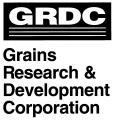surveillance
This project improved the preparedness of Australia's grain industry for incursions of Emergency Plant Pests (EPPs) by developing a national surveillance plan to support market access and provide contingency plans for threats to Australia's grains industry.
Research outcomes:
- Twenty two contingency plans for key high and medium priority pest threats to the Australian grains industry were prepared. These plans provide information on pest life cycles, potential distribution, survival strategies and methods for surveillance and sampling to assist with biosecurity preparedness.
- Audit of grain pest specific reference material held electronically by PHA was undertaken.
- Biosecurity awareness information was provided to researchers, growers, grains bulk handlers and agribusiness in the form of media articles and seminars.
- Development of surveillance plans for Russian wheat aphid, Hessian fly and Sunn pest to assist capture of data for both early detection of new pests and market access requirements.
Research implications:
The development or update of contingency plans for key pest threats and surveillance plans for Russian wheat aphid, Hessian fly and Sunn pest, together with the delivery of biosecurity messages, form an important part of biosecurity preparedness and prevention activities for the grains industry.
The development of contingency plans will provide information that will form the basis of response plans to pest incursions. The provision of information within the contingency plans will assist with more rapid eradication, containment or management mechanisms being put in place, helping both deliverers and beneficiaries of the emergency response.
Provision of awareness training and information is an important part of industry preparedness, assisting to increase the understanding of the importance of biosecurity and the response mechanisms Australia puts in place in the event of an incursion.
The surveillance plans for Russian wheat aphid, Hessian fly and Sunn pest provides a framework for a coordinated national approach to collection and capture of data for both early detection of new pests and market access requirements.
The surveillance plans assessed the probability of detection of each of these pests using routine crop monitoring. This framework has implications for all stakeholders in the grains supply chain that will be impacted by pests of market access concern or potential pest incursions.
Acknowledgements:
PHA wishes to acknowledge the CRC for National Plant Biosecurity (CRCNPB) and the Grains Research and Development Corporation (GRDC) for supporting this project.
PHA also acknowledges all experts who contributed to completion of contingency plans.
PROJECT LEADER

Dr Sharyn Taylor
Project Leader CRC30009: Grains Surveillance Strategy
staylor@phau.com.au
Phone: 02 6215 7700
Fax: 02 6260 4321
Read More
PROJECT DETAILS
Complete
Term
January 2006 – October 2008
Budget
$433,210 (cash and in-kind support)
PROGRAM DETAILS
LOCATION
CORE CRC PARTICIPANTS
There are increasing international concerns about food quality and safety. Import requirements are becoming more demanding and exporters including Australia now need not only to declare they are free from plant and animal pests and diseases, but they need to demonstrate it too. As a result, pest surveillance has become a critical tool to secure market access. Exporting countries now need to provide accurate, credible data with evidentiary chain to confirm freedom status.
Research outcomes
Technical equipment like Personal Digital Assistants (PDAs) have emerged as a powerful tool not only to collect information but also to improve the quality and application of the data collected. Cooperative Research centre for National Plant Biosecurity (CRCNPB) PDA software developed with Visual CE was successfully tested during the 2007 post-border detection of Khapra beetle in suburban Western Australia by providing evidence of complete eradication via 1,273 trap inspections. This achievement was supported by GPS-located traps, digital voice navigation itineraries, digital time and date stamps, field printed barcode labels, site imagery, Google Maps integration all in a single hand-held unit.
New PDA hardware and software continues to be developed by the CRCNPB for use in other pest surveillance activities. These include hazard site pest surveillance, stored grain fumigation monitoring, grain insect resistance testing and fruit fly phenology studies.
Research implications
Australia remains committed to World Trade Organization agreements, sanitary and phytosanitary agreements, the International Plant Protection Convention and international sanitary and phytosanitary measures. We recognises the need for quarantine plant pest surveillance data of the utmost integrity is essential to support area freedom negotiations.
With most of Australia’s agriculture produce exported, securing and maintaining market access is critical as is the need to demonstrate freedom from certain plant and animal pests and diseases. Surveillance is an important tool for securing market access and as discussed exporting countries now need to provide accurate, credible evidence to confirm absence (i.e known not to occur) for pest freedom status.
This CRCNPB project focused on the development of pest surveillance data collection software and hardware using hand-held computers or PDAs. This approach provides chain of evidence control, increases the volume of data collected as well as its integrity through relational databases and seamless data transfer to corporate systems.
Acknowledgements
Damian Shepherd, Iain Martin, John Bruce (Department of Agriculture and Food Western Australia (DAFWA) Spatial Information Systems) and Bob Vassallo (DAFWA Animal Biosecurity) provided technical input. Department of Fisheries and Forestry Surveillance Reference Group participants collaborated with beta testing the Urban Surveillance application; Peter Gillespie, Deborah Kent, Craig Murdoch, Tony Monteith, Rebecca Yarrow, Bruce Baker, Wayne Marshall, Russell Elliott, Megan Szczerbanik, Nita Ramsden, James Swan, Heather Wallace, Richard Johnston, Cain Roberts, Melanie Hay, Jo Slattery, Sharyn Taylor, Stephen Dibley, Paul Pheloung, Gareth Men, Greg Hood, Debra Riddell, Peter Frecklington. Shirani Poogoda (DAFWA) beta tested the Fruit Fly Phenology application. Ern Kostas (CBH Group) beta tested the Grain Fumigation application. Peter Davis (DAFWA) beta tested with ant surveys on Christmas and Norfolk Islands.
PROJECT LEADER

Mr Robert Emery
Project Leader CRC30014: PDA-Assisted Surveillance (phase one)
remery@agric.wa.gov.au
Phone: 08 9368 3247
Fax: 08 9368 3223
Read More
PROJECT DETAILS
Complete
Term
September 2006 – August 2009
Budget
$436,800 (cash and in-kind support)
PROGRAM DETAILS
LOCATION
Outcome
Detection: More effective national surveillance systems.
Goal
A more effective national surveillance system based on scientifically sound sampling tools and survey methodologies.
Indicators of success
Economic:
Deployment of new monitoring applications to enhance scientific defensibility of market access for stored grains.
Science:
Surveillance tools developed and peer reviewed through scientific publication and invitations to present at key meetings, conferences and workshops.
Policy:
New surveillance tools and procedures are used by end-users to support market access outcomes.
Capacity/Collaboration:
Tools and standardised procedures are delivered to end-users through training.
Impact/Adoption:
New tools (statistical tools, automated traps, Personalised Digital Assistants) are used by end-users to enhance existing surveillance processes.
Surveillance Research Projects
| Title | Leader |
| CRC30009: Grains Surveillance Strategy | Dr Sharyn Taylor |
This project improved the preparedness of Australia's grain industry for incursions of Emergency Plant Pests (EPPs) by developing a national surveillance plan to support market access and provide more | |
| CRC30014: PDA-Assisted Surveillance (phase one) | Mr Robert Emery |
There are increasing international concerns about food quality and safety. Import requirements are becoming more demanding and exporters including Australia now need not only to declare they are more | |
| CRC30015: Hyperspectral Pathogen Detection | Ms Alison Mackie |
The project will provide improved surveillance tools for rapid, widespread detection of plant pathogens in crops and native vegetation by producing a library of unique spectral signatures that more | |
| CRC30022: Female Lures: Fruit Fly Trapping | Dr Katina Lindhout |
This project developed female fruit fly lures to improve pest surveillance technology. These will aid in the detection and control of fruit fly species not attracted to the currently deployed more | |
| CRC30023: Smart Trap Scoping Study | Dr Louise Morin |
Biosecurity insect trapping programs in Australia use low-cost or disposable units which are inspected on a weekly or fortnightly basis, and re-lured or replaced monthly or quarterly. Inspectors more | |
| CRC30032: Flying Spore Traps | Felipe Gonzalez |
This project was a scoping study to determine the potential of using an unmanned aerial vehicle, fitted with a spore trap, to detect and monitor spores of plant pathogens. The aim was to develop a more | |
| CRC30039: Fruit Fly Area Freedom | Dr Francis De Lima |
This project developed a dynamic, strategic trapping system which provides a similar or higher level of confidence as current static, passive grid systems in areas free from Queensland and more | |
| CRC30062: AIMS | Mr Robert Emery |
The aim of this project is to develop a rapid and customised (for Australia) internet web crawler which will detect organisations who would intend to market via the internet, regulated organisms more | |
| CRC30064: Resistance management of stored grain insects in the southern region | Dr Joanne Holloway |
Resistance in grain storage insects to chemical treatments continues to be a problem throughout the southern region. Regional surveys have detected new sites of strong phosphine resistance, with more | |
| CRC30065: Resistance monitoring and management of stored grain insects in the northern region | Dr Manoj Nayak |
A range of grain storage pests including beetles, psocids, moths and mites habitually threaten the food safety, market access, trade and the overall profitability and sustainability more | |
| CRC30086: Stored Grains Sampling Strategies | Dr Grant Hamilton |
This project developed flexible and statistically robust systems to calibrate and improve sampling strategies where required for the detection of post-harvest grain storage pests, and for more | |
| CRC30133: Urban surveillance | |
There are two important reasons why pests including Emergency Plant Pests (EPPs) can become established in urban areas and spread to nearby horticultural or agricultural areas. First, urban more | |







